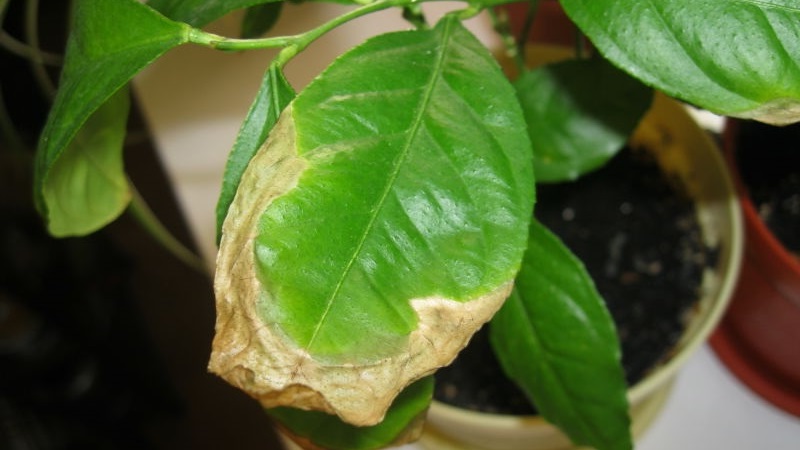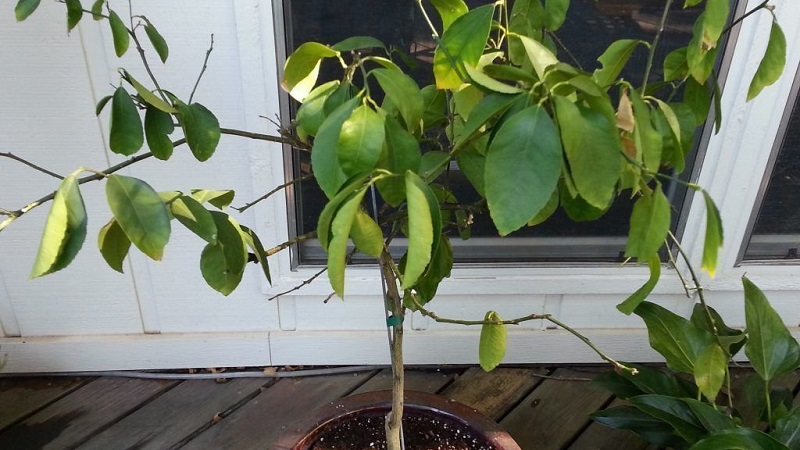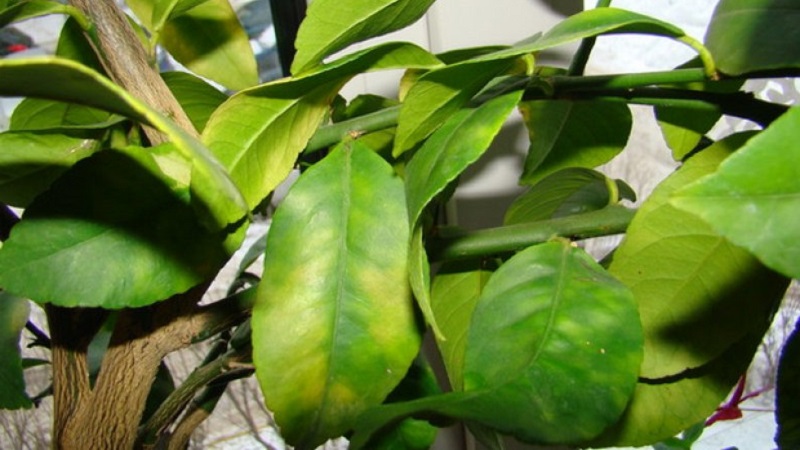Why lemon leaves dry at the edges and how to fix the problem
Lemon is a subtropical inhabitant that, when grown at home, needs to maintain a comfortable climate. The plant loves moisture, sun, heat, does not tolerate cold, drafts, lack of nutrition and moisture. Dry leaves and branches, foliage shedding out of season indicate that the plant is under stress. In this article, we'll talk about growing lemon at home, caring for it, and what to do if the lemon tree is dead.
The content of the article
Why does lemon dry leaves around the edges
Most problems with growing indoor lemons are due to improper care.... The plant needs regular but moderate watering, sunlight, feeding with organics and minerals, maintaining the temperature and humidity of the air.
Mature trees shed their old foliage once a season, which should not be alarming. florist. But when the lemon turns yellow and leaves curl, the trunk and branches dry, it is important to identify the cause of such processes and direct efforts to resuscitate the plant.

Lack of lighting
The harmonious development of the lemon tree depends on the level of light in the house.... A lack of sunlight adversely affects the plant and leads to dry tips and yellowing of the leaf plate.
The norm of daylight hours for a lemon is 12 hours... The tree is placed on the windowsill or near it from the southwest or south side to provide comfortable conditions for growth and development. Otherwise, the lemon is supplemented with a phytolamp.
Excessive sunlight often causes yellowing and dry leaves.... At the same time, the branches and the trunk of the tree dry up. Direct sunlight penetrates the glass and causes burns on delicate leaves, so growers advise against placing a lemon tree on sun-drenched windowsills.
Better to put the pot on a curbstone near the window or shade with a chintz curtain.
Over or under watering
Lemon is a moisture-loving plant, therefore, due to a lack of moisture, the leaves on it become dry and twisted... In the summer, it is watered every day, in dry weather, the frequency of watering is doubled. Water is poured in small portions and the soil is constantly checked for moisture content. The finger is immersed in the ground 2-3 cm. If it is dry, then it's time to add a portion of water.
Dry trunk and branches also indicate excess moisture... Excessive watering causes rotting of the root system and the quick death of the plant. In this case, it will no longer be possible to save it, but it will be possible to grow a new tree from cut and rooted cuttings.
If there are no drain holes in the pot or clogged, drainage material was used during planting that does not allow water to pass through, the root system will begin to rot. Excessive moisture causes oxygen starvation of the plant, discharge and yellowing of foliage.
The quality and temperature of the water also affects the condition of the tree.... For irrigation, use clean, settled, filtered or spring water at room temperature. The stem of a lemon also dries up when watered with ice water, which causes shock to the root system.
Interesting on the site:
Soil depletion
The growth and development of indoor lemon depends on the nutritional value of the soil.... For planting, use soil mixtures marked "For citrus plants." After planting, the young plant is weekly fed with liquid fertilizers for lemon (Rocon, Bona Forte, Fasco, Garden of Wonders Lemon, Zdraven, Organic Mix). In conditions of a deficiency of nutrients, the lemon quickly sheds its leaves, and the trunk and branches begin to dry out.
In summer, lemon grows and gains green mass. During this period it is recommended apply fertilizer once a week. In winter, they switch to a sparing regime and feed the plant once every 2 weeks.
At home fertilize lemon with improvised means:
- Nitrogen. Silt or crushed quinoa leaves are placed as a top layer of soil in a pot with a plant or watered with a 0.5% solution of nitrate.
- Phosphorus. Mix 2 g of bone glue with 1 liter of water, boil for half an hour, cool and pour over lemon. 50 g of superphosphate is added to the fermented slurry and the plant is fed.
- Calcium, phosphorus, potassium. These substances are found in wood ash. For 1 liter of water add 1 tbsp. l.
- Coffee grounds or tea leaves that contain magnesium, potassium, calcium, phosphorus, manganese, copper, iron and are suitable as a supplementary feeding.
- A dark solution of potassium permanganate. It nourishes the plant and disinfects the soil.
- Organic. Manure or bird droppings are diluted with water, fermented for 10 days, then diluted with water 1:15.

Dry indoor air
The heating season negatively affects the indoor air quality, it becomes drier.
Lemon reacts to changes in microclimate with dry and twisted foliage... The situation will be corrected by spraying the tree 3 times a day, installing a humidifier or container with water next to the pot. For spraying, use clean, filtered water. From the tap will not work, because it leaves a white coating on the foliage.
Sphagnum moss or damp cotton cloth will help to retain moisture in the soil and prevent drying out of the root system.
Reference. The air humidity in the lemon growing room is 60%.
Temperature violation
Sharp jumps in indoor air temperature cause dry leaves... Citrus fruits love warmth, are afraid of cold and drafts. A pot with a tree is placed away from vents and doors.
In winter, the lemon is removed away from the batteries, since overheating of the earthy coma and the plant itself leads to shedding leaves... The room is regularly ventilated, making sure that the air currents do not fall on the tree.
Most varieties can easily withstand a gradual decrease in temperature. from +25 to + 10 ° C. Comfortable values for citrus fruits are + 20… + 22 ° C.
The appearance of pests and diseases
A spider mite settles on a lemon tree and causes dry leaves and branches... When damaged by a scabbard, growths and dry areas appear on the leaves.
Ways to destroy pests:
- Pour 100 g of onion husks with 200 ml of warm water, leave for 24 hours, then water the soil and spray the leaves;
- grind the head of garlic in a mortar, pour 200 ml of warm water, leave for 5 days in the dark, strain and spray the leaves;
- 100 g of dry herb yarrow pour 1 liter of boiling water, put on low heat for half an hour, strain, cool and spray the leaves;
- 100 g of dry dope ordinary pour 1 liter of warm water, leave for 24 hours, strain, mix 5 g of shavings of laundry soap, then process the plant;
- 100 g of dried henbane pour 1 liter of boiling water, leave for 24 hours, strain and process the lemon;
- colloidal sulfur solution is used in this way - lemon leaves are sprayed with water mist and powder is blown off the paper;
- "BI-58" (10 drops per 200 ml of water) - treat in the evening, after 2 days rinse the foliage with running water;
- "Karbofos" - to process according to the instructions, the product destroys aphids and spider mites;
- INSEKT SPRAY - aerosol for home use;
- Plint Pin arrows against the spider mite are stuck into the ground 3-4 pcs. on the pot;
- "Aktara" against scale insects, thrips, aphids - 0.4-0.8 g per 1 liter for processing lemons;
- "Thiophos" against the scabbard - 3-5 treatments with an interval of 10-20 days.

All the leaves of the lemon have fallen off and the branches are drying - what to do
Resuscitation success and lemon tree treatments depends on the speed of identifying the cause of dry leaves and branches. At the initial stage, the problem can be solved quickly, but delay threatens to lose the tree.
If, against the background of excessive watering, the roots began to rot, the lemon is transplanted into a new pot with a complete replacement of the soil. The damaged roots are cut off, the remaining ones are washed in a solution of potassium permanganate.
If sunburn appears on the leaves, the plant is transferred to partial shade or covered with curtains from the scorching rays.
Damaged and dry leaves are removed, young green leaves appear instead.
The room maintains a comfortable air temperature and humidity level... The tree is put under a shower every six months to wash away dust and spider mites from the foliage, but after that it is watered when the soil is 4-5 cm dry.
How to reanimate dried indoor lemon
Even with proper care, indoor lemon dries and sheds foliage. When a tree is watched, it is much easier to maintain its health. However, citrus growers often give up when they see a plant in a deplorable state.
Our tips will help you understand how to revive Pavlovsky lemon and give it a second life:
- Place the pot on a balcony in a bright spot.
- Remove the lemon from the pot to inspect the roots, remove the dead and leave at least 80% of the total mass.
- Cut off dry branches along with foliage, they can no longer be saved.
- Place the plant in a sterile medium and under the bag for 30 days.
- Stop feeding the plant until the cause of the dryness is determined.
- Plant the lemon in loose, lightweight, breathable soil.
- Add coconut, peat, perlite and 20 g of superphosphate before planting in a new substrate.
- Water after the topsoil is dry.
- Plant grass or spread moss to prevent soil souring.
- Water the plant with "Radifarm", "Energen Aqua", spray with "Zircon" and "Eco-gel" solution once a week.
Conclusion
Experienced citrus growers know what to do if a lemon has dried up. They recommend maintaining the air temperature in the room in the range of + 20 ... + 22 ° C, humidity at 60%, watering the plant only after the topsoil has dried out, and monitoring the condition of the root system.
For lemon, overflow is worse than moisture deficit. In such cases, the roots begin to rot, which leads to the death of the tree. Lemon leaves dry when infested with spider mites and scabies. For destruction, folk remedies and insecticides are used.